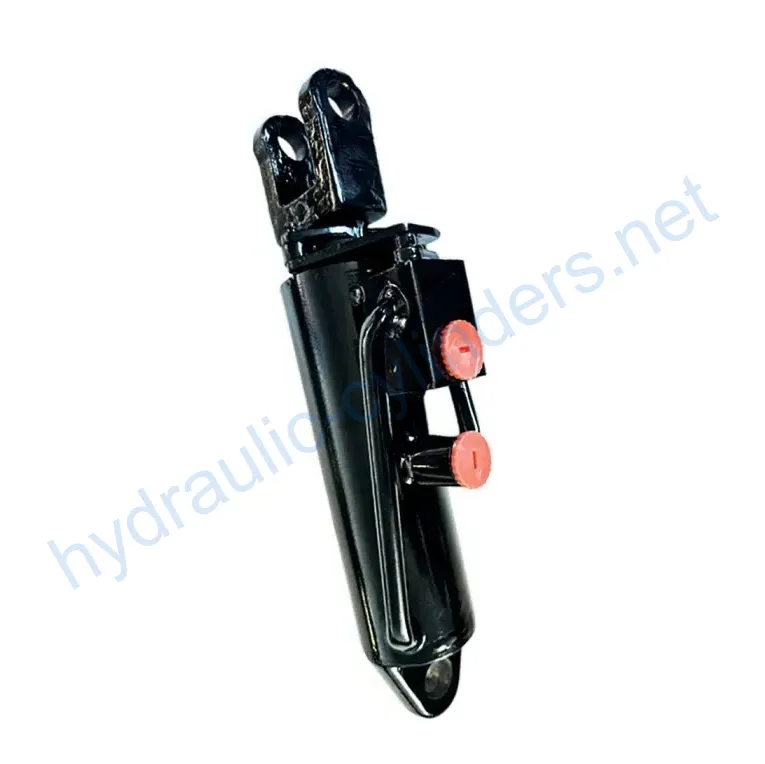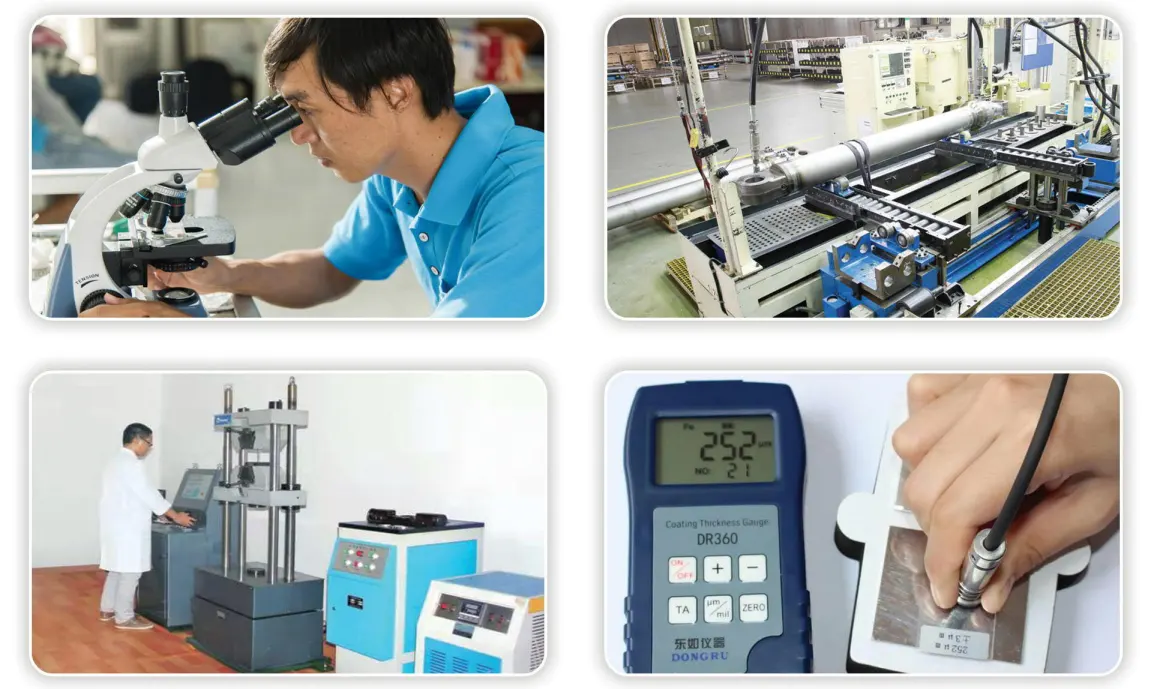FT800 55A 012 Lifting Cylinder
As one of the hydraulic cylinders manufacturers, suppliers, and exporters of mechanical products, We offer hydraulic cylinders and many other products.
Please get in touch with us for details.
Mail:sales@hydraulic-cylinders.net
Manufacturer supplier exporter of hydraulic cylinders.
Limit Lifting Cylinder

Understanding the Lifting Cylinder
The lifting cylinder is an essential component in various industries, serving as a powerful actuator that converts hydraulic pressure into linear motion. With a compact design featuring a cylinder diameter of 63mm, rod diameter of 35mm, and a travel length of 120mm, this hydraulic lifting cylinder is ideal for applications requiring precise control and robust performance. The calculated installation distance of 335mm ensures it fits seamlessly into equipment setups. The advantages of this hydraulic lift cylinder include its durability, efficiency, and ability to handle heavy loads, making it suitable for heavy machinery demands.
Key Features of the Lifting Cylinder
- High Load Capacity: Designed to withstand heavy loads, making it perfect for hydraulic lifting cylinder for heavy machinery.
- Durable Construction: Built with robust materials to ensure longevity and reliability in demanding conditions.
- Efficient Performance: Ensures smooth operation with minimal downtime, contributing to effective lifting cylinder repair guide.
- Versatile Applications: Suitable for various settings, from construction to automotive, enhancing the utility of hydraulic lift cylinders.
- Easy Installation: Engineered for straightforward setup, aligning with lifting cylinder installation best practices.
Applications Across Industries
The lifting cylinder finds applications across numerous sectors:
- Industrial Machinery: Used in presses and assembly lines to facilitate lifting operations.
- Construction Equipment: Essential for cranes and excavators to perform heavy lifting tasks.
- Automotive Industry: Integral in vehicle assembly and repair processes, ensuring safety and efficiency.
- Material Handling: Employed in forklifts and conveyors to enhance loading and unloading capabilities.
- Aerospace and Defense: Utilized in specialized equipment that requires high reliability and precision.

Design Considerations and Selection Criteria
Load Capacity
When selecting a lifting cylinder, understanding its load capacity is crucial. A cylinder must be able to support the weight it will handle without risk of failure. Manufacturers provide specifications detailing the maximum load limits, and it is essential to adhere to these guidelines to ensure safety during operation. Selecting a cylinder with a sufficient load capacity will prevent overheating and extend the lifespan of hydraulic lifting cylinders.
Sealing Systems
Effective sealing is vital to maintaining the integrity of the hydraulic system. A well-designed sealing system will prevent hydraulic fluid leaks, which can lead to system failures. Modern lifting cylinders often use advanced sealing materials, such as polyurethane and nitrile rubber, which offer excellent wear resistance. Ensuring that the cylinder is equipped with high-quality seals contributes to the overall reliability and efficiency of the hydraulic lift cylinder.
Durability
Durability is another important design consideration. The environment in which a lifting cylinder operates can be harsh, with exposure to contaminants and extreme temperatures. Thus, selecting cylinders made from robust materials that can withstand these conditions is crucial. Manufacturers often conduct extensive testing to guarantee that their products meet stringent durability standards, ensuring a long service life.
Safety Features
Incorporating safety features into a lifting cylinder design is paramount. These may include pressure relief valves and overload protection to prevent catastrophic failures. It is essential to consider these features during selection, as they not only enhance operational safety but also comply with industry regulations.
Maintenance and Repairability
Lastly, ease of maintenance and repair must be factored into the design. A lifting cylinder that is easy to inspect and service can greatly reduce downtime and repair costs. Look for designs that allow for straightforward access to key components, enabling efficient inspections and repairs, which is critical for maintaining functionality.
Sealing and Lubrication of the Lifting Cylinder
Proper sealing and lubrication are essential for the smooth operation of a hydraulic lifting cylinder. Various sealing components, such as piston seals and rod seals, are utilized to ensure that hydraulic fluid remains contained within the cylinder. It is crucial to select seals made from wear-resistant materials like polyurethane and nitrile rubber, which enhance durability and performance.
The cylinder body and threaded end surfaces require meticulous finishing to increase wear resistance. Regular maintenance includes checking and replacing seals to prevent leaks and ensure efficient operation. Additionally, timely lubrication with the appropriate hydraulic oil is vital to minimize friction and wear on moving parts. This not only prolongs the lifespan of the cylinder but also ensures optimal performance during operation, aligning with best practices for lifting cylinder specifications.
Preventive Maintenance Measures
- Regular Inspections: Conduct routine inspections to identify potential wear or damage early. This preventive measure allows for timely interventions, ensuring that all components function correctly.
- Lubrication Schedule: Establish a maintenance schedule for lubrication to keep the lifting cylinder in optimal working condition. Use the recommended hydraulic oil and ensure that it is applied at the appropriate intervals.
- Sealing Replacement: Monitor the condition of seals and replace them as necessary. Deteriorated seals can lead to leaks, impacting the efficiency and safety of the hydraulic system.
Installation Guidelines for the Lifting Cylinder
Proper installation is crucial for the effective functioning of a lifting cylinder. Follow these steps for a successful setup:
- Preparation: Before installation, ensure that all components are clean and free from debris. This includes the mounting surfaces and the cylinder itself.
- Alignment: Proper alignment of the cylinder is critical. Use appropriate mounting brackets to secure the cylinder in place, ensuring that it is aligned with the load it will handle.
- Connection: Connect the hydraulic lines carefully, ensuring that there are no leaks. Use thread sealant if necessary to create a tight seal.
- Testing: After installation, conduct a thorough test to verify that the cylinder operates correctly under load. Monitor for any abnormal noises or leaks during operation.
Maintenance Tasks for the Lifting Cylinder
- Regular Inspections: Schedule frequent inspections to check for signs of wear, especially in the seals and rod. This proactive approach is key to identifying issues before they escalate.
- Proper Lubrication: Maintain an appropriate lubrication routine to ensure smooth operation. Apply the recommended hydraulic oil consistently to minimize wear and extend component life.
- Seal Replacement: Monitor seals and replace them when they show signs of deterioration. This maintenance task is crucial for preventing leaks and ensuring the efficiency of the hydraulic system.
Safety Considerations and Environmental Factors
When using a lifting cylinder, adhering to safety measures is paramount. Ensure that operators are trained in proper usage techniques to minimize the risk of accidents. Incorporating safety features such as overload protection can prevent catastrophic failures. Additionally, environmental factors such as exposure to harmful substances or extreme temperatures should be considered during the cylinder’s operation. Implementing regular maintenance and inspection routines can mitigate risks and enhance the overall safety of hydraulic lift cylinders.
Fault Diagnosis and Common Issues
- Leakage: One of the most common issues with hydraulic cylinders is fluid leakage. This can stem from worn seals or improper installation. Regular inspections can help detect leakage early.
- Reduced Performance: A significant drop in lifting efficiency may indicate internal damage or contamination. Monitoring performance metrics can help diagnose this issue.
- Abnormal Noises: Unusual sounds during operation, such as grinding or rattling, often signal mechanical issues. Investigating any unusual sounds can prevent further damage.
Troubleshooting Tips and Solutions
To effectively troubleshoot issues with a lifting cylinder, consider the following guidelines:
- Check for Leaks: Identify and address any leaks immediately to prevent fluid loss and ensure proper functionality.
- Inspect Internal Components: Regularly inspect the internal components for wear or damage, ensuring that all parts are in good condition.
- Maintain Proper Fluid Levels: Ensure that hydraulic fluid levels are adequate, as low fluid can lead to performance issues. Regularly check and replenish as needed.
Taking preventative measures reduces the likelihood of common issues, promoting a longer lifespan for the hydraulic lifting cylinder.
About Our Company
We are a leading manufacturer of lifting cylinders, recognized as one of the foremost producers and wholesalers of hydraulic cylinders in both domestic and international markets. Our commitment to excellence is underscored by our refined manufacturing processes and stringent quality control measures. With a focus on advanced technologies, we leverage skilled personnel and high-end digital manufacturing equipment to enhance our production management strategies.
Our robust capabilities allow us to meet diverse customer needs efficiently and accurately. We provide professional consulting and customized services tailored to your requirements, ensuring optimal performance for every application. Our international certifications further solidify our reputation for quality, while our dedicated after-sales support ensures customer satisfaction.

Take a Tour of Our VR Factory:
Take a tour of our VR factory with the following
Hydraulic Cylinder Application:


